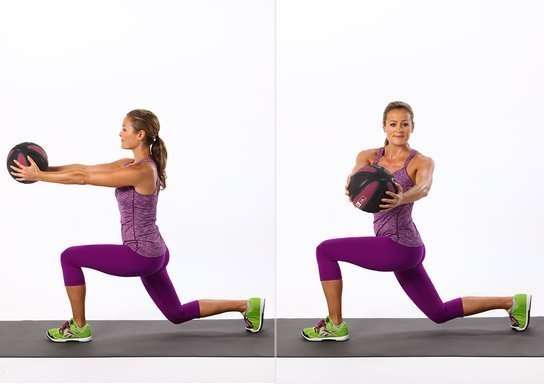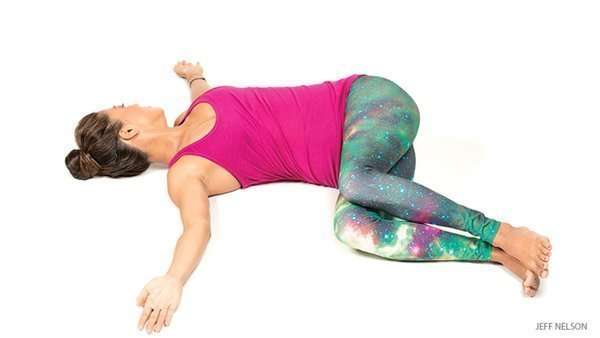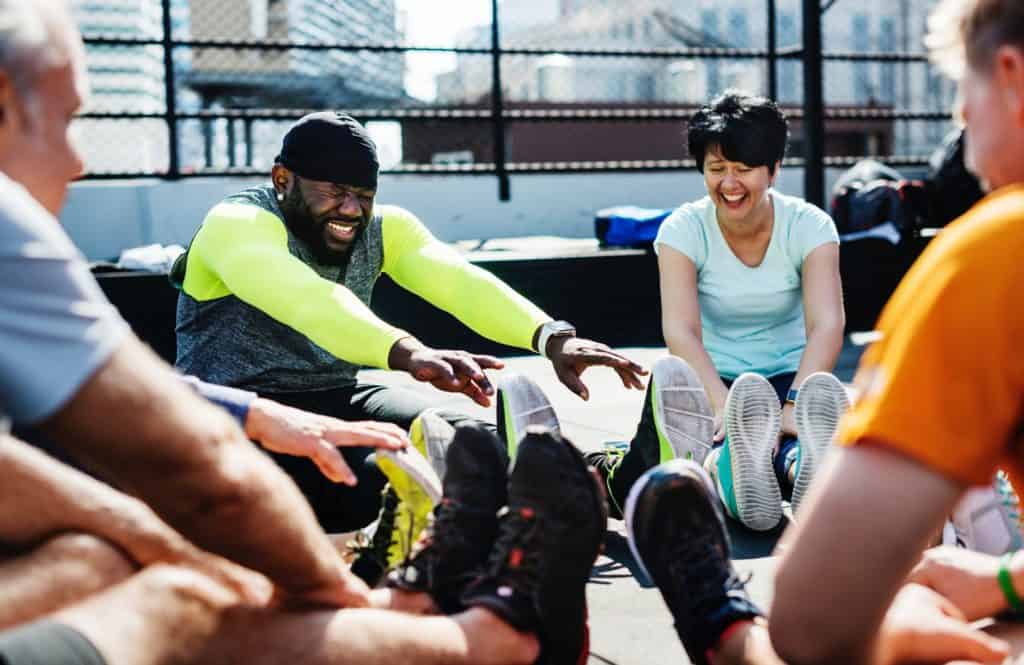Core Power
When most people hear the word ‘Core,’ they probably think of abs. Our torso holds some of the most coveted muscles in our bodies. Abs and obliques are highly prized by bodybuilders, fitness gurus, and the average person alike, but we don’t always follow a good core regimen, including both, the workout and nutrition.
The core is far more than a nice set of muscles to look at, however. It plays an enormous role in nearly every activity that we perform each day, supporting and balancing us as we move.
Our core also helps to keep our organs, ribcages, and even our spine in some ways, safe from impacts or other potentially dangerous events.
A strong torso is important for lots of reasons, and not including a solid core workout a few times a week is probably hurting you more than you think.
How Does Your Core Help You?
We don’t always pay enough attention to our core. Generally, it exists without a thought, just hanging out as we slouch about our days. It is no secret that people in western society have collectively forgotten about our cores, leaving them to soften up. A softer torso, however, comes with tons of issues, including poor posture.
American posture is collectively terrible, for lack of a nicer way to say it. Our spines hunch over and our shoulders roll forward.
That isn’t healthy, though, and posture is generally an easy fix barring actual structural issues. A strong core helps your overall posture, sitting upright, walking taller, and exuding confidence as you go about your day.
It also helps you to do other things, though. Lifting heavier weights is an obvious example, so a strong core can help you out on other gym days, run marathons, and even climb over obstacles.
In short, your core does far more than we generally give it credit for, so let’s give our core the workout it deserves.
Anatomy of Your Mid-Section

Knowing the anatomy of the area you are going to be working out is important if you want to properly train. A solid core workout hits all of the major muscles in the region, but how can you do that if don’t know what is where, or where they actually are?
Your core consists of more than ‘just’ your Abdominals and Obliques, but those are the muscle groups that most well known and trainable.
Oblique Muscles
Obliques are separated into internal and external groups.
The internal oblique muscles are located on either side of your abdominals, running from your hips to your ribs. Your internal obliques allow you to rotate your torso in either direction.
Your external oblique muscles are located directly next to the internals, still on your sides near the ribcage, heading towards your back and down to your hips. They help with hip flexing, and are heavily used for stability and power generation through the legs as well as leaning to either side.
For all intents and purposes, you can consider these muscles to be one set. They do not work without the other.
Abdominal Muscles
Just like the oblique muscle, your abs are made up of two muscle groups. The “Rectus Abdominis” and the “Transversus Abdominis.”
The Rectus Abdominalis group is what people think of when they hear the term ‘core.’ A ‘six-pack.’ These muscles are responsible for spinal flexing, allowing for us to bend forward.
Your Transversus Abdominalis muscles ‘lives’ underneath your rectus abdominalis, and helps with lots of things, including breathing, stabilizing lower back movements, and keeping your spine in place.
Again, these two muscle groups can be considered as one.
Not only does your core play a large role in how your body moves, but these muscles are also responsible for protecting your rib cage and internal organs, and the relative strength of these muscles can alter your daily life for better or worse.
Need some help?
Shape Success, Live Exceptionally
Hit that button, and get started today.
When to Train
Unlike some other muscle, you will get a decent amount of core exercise each time you work out other muscle groups. Squats, for example, require core engagement in order to avoid crumbling under heavy weights. Even other exercises, such as dips, might not seem be a likely candidate for using your core, but you need to engage your core so you don’t swing wildly while you push yourself upwards. Runners heavily engage their core to generate power and move their hips, as well.
Additionally, you can and should perform a few core exercises 2- 3 days a week after you are finished working out as well. Do 3 – 4 core centric exercises each time, to avoid overtraining.
In short, core is a versatile muscle group that can be trained in a diverse number of ways. Just don’t ignore it.
Core Warmups
Before any workout you do, make sure you properly warm up your muscles. Take 5-10 minutes to get your blood flowing. This helps to get your muscles ready for the work you are about to have them do, bringing them extra oxygen and nutrients in the process.
Jogging, rowing, and even a gradual climb using a stair master for 5-10 minutes will bring your heart rate up, and get the blood moving into your muscles.
Don’t forget to also get yourself into the right mindset while you warm up. Visualize what you are going to be doing, and see yourself getting it done. Going into a workout, no matter how well planned, can be sub-par if you don’t go into it with the right mindset.
After your muscles are warm, take another 5-10 minutes to do some dynamic stretches and really prime those muscles and get them as elastic as possible before heading into the actual exercises.
Here are some good movements to help get your muscles ready for a solid core workout:
Lunge with a Twist: 5 per side
Adding a twist to a lunge is a great way to engage your core muscles, helping to prime your abdominals and obliques for what you are about to put them through.
How to do them: From a standing position, step forward, and lunge. Once you are deep into the lunge, hold it, and slowly twist your body in one direction until you start to feel a stretch. Slowly twist the other direction until you feel the stretch, returning to the center before you stand back up. Repeat, alternating which foot steps forward.

Hip Bridge: 10-15 Slow Repetitions
Most people think the hip bridge is only good for your glutes, but it is a great warm up for your core, engaging most of those muscles in the process.
How to do them: Lay on the floor with your arms flat by your sides, hands facing downwards, and bring your feet in towards your butt. Your knees should be in the air with your feet flat on the ground. Slowly, lift your hips off the ground, tightening your abdominal muscles in the process. Your body should be straight, and look like a board from your shoulders to your knees. Slowly return your hips to the ground.
Pro Tip: If you slowly rotate your torso and reach each arm to the opposite side while your hips are in the air, you can bring your obliques into the fold as well.
Torso Twist: 6-12 Slow Repetitions
This movement engages the entirety of your core, as well as your lower back and the rest of the stabilizers in the area.
How to do it: Lay on your back, stretch your arms outward at chest level, your palms on the ground. Bring your knees up to a 90° angle. Your feet will be off the floor at this point. Once you are in the starting position, twist your torso to one side, keeping your palms, arms, and shoulders on the floor. The goal is to have your knees touch the ground on either side. Hold it for 20 seconds and slowly rotate to the other side.
Workout
Once you are properly warmed up, you can jump into the ‘core’ of the workout.
A good core workout is one of the easiest routines to perform because you don’t actually have to go anywhere. Most of the movements are all body weight, unless you want to add weight. Extra equipment isn’t at all necessary, so you can do it anywhere, your living room included. Throwing it into the end of another workout, however, is incredibly easy and convenient.
Since your core muscle functionality all revolves on bends and twists, those are the types of movements you should aim to do.
V-Ups: 3-4 sets 15-20 reps

V ups are fantastic. Not only do they strengthen your abdominal muscles, they also work on your balance,.helping your stabilizers work more efficiently throughout the day.
How to do them: Lay flat on the floor, facing the ceiling. Your arms should be extended above your head, laying on the floor. Begin to tighten your core, raising not only your arms, but your legs as well. They should both remain straight and extended, with only your core moving. At the most contracted point, only your butt should remain on the ground. Your arms will still be over your head, fully extended, and your legs will be raised off the ground, fully extended. Once contracted, slowly lower yourself back down to the starting position.
Hanging Leg Raise: 10-15 reps per side OR 15-20 reps to the front
Hanging leg raises are incredibly versatile. You can do them with bent knees or straight legs, contracting your core to the front or either side. Which direction you lift and move, determines which muscles are activated, so a good mix within any fitness regimen is a necessity.
How to do them: From a stationary hanging position on a pull up bar or using a leg raise machine, slowly lift your legs, bending at the waist. When you cannot contract any further, pause, and slowly return to the starting position.
Plank: 4-6 reps x 30 seconds – 2 minute hold
The trusty plank. This movement engages your entire core, front, back, and sides. Remaining in a flat, board like position for extended periods of time forces the body to engage everything it can so that it can support your weight in an otherwise strange position.
How to do them: Starting in a push up position, prop yourself up on your elbows similar to an actual push up. Keeping your elbows directly under your shoulders, lock them in place. Try to keep your back as straight as possible, and hold for a set period of time. Lower yourself slowly back down to the ground and take some rest before doing another set.
Dead Bug: 5-10 reps per side
Dead bugs are an interesting exercise. They mimic a dead bug that was flipped onto its back, which, conveniently, engages most of your core.
How to do them: Start in the same position as a v up, laying flat on the floor. Extend your arms towards the ceiling and pull your knees up at a 90° angle. Alternating sides, slowly lower one arm and the opposing leg at the same time. Once they reach to the floor, and without resting them on the floor, return to the starting position. Repeat, alternating sides each time.

Seated Torso Twist: 10-15 reps per side
Twisting at the torso engages the obliques in ways that simple crunches cannot. Engaging the entirety of the core is necessary to strengthen it completely.
How to do them: Sit on the floor with your legs pulled in similar to the upwards position in a sit up. From this position, lift your feet off the floor, keeping your knees bent. At this point, only your butt is on the ground. Twist your torso in either direction, going as far as you comfortably can before slowly then turning the other way.
Tip: Keep your back straight as you twist to reduce the potential for injury, and twist in a controlled manner.
Cool Down
End every core workout with a good cool down. This will help you avoid cramping and soreness. Take a few minutes to do some stretching, to lengthen the muscles and try to pull out any knots they may have developed before they become stuck.
Cobra Pose: 2-3 sets x 10 – 15 second hold
Regardless of how you feel about it, Yoga is great for the stretches and increased flexibility it brings along, if nothing else. The cobra pose is one of the most fantastic poses, stretching pretty much the entire front core.
How to do it: Start in a push up position, palms down on the ground at chest level. Push yourself up, slowly stretching yourself upwards, keeping your hips on the ground. You will feel a slight pull in your core.
Overhead Stretch: 3-4 reps x 10 – 15 sec hold
Want to test your overall upper body flexibility? This stretch will do just that, targeting everything from your abdominals to your shoulders and outer chest.
How to do them: Lie flat on the floor, facing upwards. Lift your arms, extending them towards to the ceiling. Slowly, lower your arms towards the ground above your head. You should be able to get them almost down to the ground over your head. Don’t push too hard, stopping when you feel a stretch in your core.
Laying Oblique Twist: 3-4 reps x 10 – 15 sec hold

The oblique twist is great because it not only stretches your core, but also helps with hip and low back flexibility. Both, your hips and low back, are influenced and stabilized by your core, so this is a great all around stretch.
How to do them: Lay flat on the ground, with your arms extended outwards at shoulder level, keeping your palms facing downwards. Slowly lift one leg off the ground and rotate your torso, bringing that leg over the other. Try to touch the floor on the other side of your resting leg, keeping both shoulders on the ground. You should feel a stretch in your back and core.
Recovery
As always, it is very important to help your body recover. Giving your body what it needs after any workout can help speed up your progress, and reduce the chance of injury. The same concept applies to a core workout.
Make sure you are properly feeding your body everything it needs before, during, and after exercise. Hitting all of your nutritional requirements are a necessity if you want to see progress.
Also, be sure to properly hydrate and rest. Without adequate water, rest, and sleep your body doesn’t perform as efficiently as it could. This applies to every day life as well, so make sure you don’t ignore this.
Conclusion
While it is true that, visually, abs are indeed made in the kitchen, a strong core is a necessity for anyone with any sort of fitness ambitions. Your core can help you stand up straighter, be more confident, and lift heavier. It can also help you move around easier, reduce the potential of spinal injuries, and cushion your organs in the event of an accident.
Additionally, no matter how strong your upper and lower body is, without that strong midsection to pull it all together, you are probably missing out on quite a bit of power generation. Don’t cheat yourself.
Take some time a few times a week to work in core exercises at the end of 2 – 3 workouts a week. Your back, shoulders, and mind will thank you.
Let Us help You Out
At CONDITIONerd we are here to help you achieve better physical and mental health through exercise. Check out the plans we offer to our customers and see if you could benefit from working with our team. And if you have questions, you can always contact a CONDITIONerd team member.
Personal trainers, like those found here, can help guide you on your pathway towards reaching your fitness goals, whether that is getting bigger, stronger, faster, more lean, or just generally feeling better.
We can get you setup with a periodized workout plan, supplement information, and advice on nutrition to help you reach your goals.
The only thing you need is some motivation and a willingness to change some old habits.
Get into contact with us to find out what membership is right for you. In a CONDITIONerd program, you’ll be surrounded by others who can help you to get where you want to be.
Generally, our clients start to see some pretty awesome changes in 2-3 months time, some sooner.

